|
|
|
Sort Order |
|
|
|
Items / Page
|
|
|
|
|
|
|
| Srl | Item |
| 1 |
ID:
100990
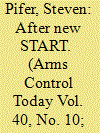

|
|
|
|
|
| Publication |
2010.
|
| Summary/Abstract |
Assuming the New Strategic Arms Reduction Treaty (New START) is ratified and enters into force, the question will be, "What next?" Speaking in Prague in April 2009, President Barack Obama called for reducing the role and number of nuclear weapons and articulated the goal of a world free of nuclear arms, albeit only when certain conditions are met. He and his Russian counterpart, President Dmitry Medvedev, have agreed to a step-by-step process for reducing nuclear weapons.
|
|
|
|
|
|
|
|
|
|
|
|
|
|
|
|
| 2 |
ID:
103825
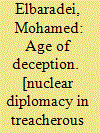

|
|
|
|
|
| Publication |
London, Bloomsbury Publishing, 2011.
|
| Description |
340p.
|
| Standard Number |
9781408817001
|
|
|
|
|
|
|
|
|
|
|
|
Copies: C:1/I:0,R:0,Q:0
Circulation
| Accession# | Call# | Current Location | Status | Policy | Location |
| 055947 | 327.1747/ELB 055947 | Main | On Shelf | General | |
|
|
|
|
| 3 |
ID:
061655
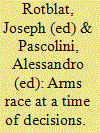

|
|
|
|
|
| Publication |
London, Macmillan, 1984.
|
| Description |
xxiv, 291p.
|
| Standard Number |
033376498
|
|
|
|
|
|
|
|
|
|
|
|
Copies: C:1/I:0,R:0,Q:0
Circulation
| Accession# | Call# | Current Location | Status | Policy | Location |
| 024467 | 355.825119/ROT 024467 | Main | On Shelf | General | |
|
|
|
|
| 4 |
ID:
038675
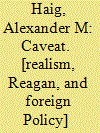

|
|
|
|
|
| Publication |
London, WeidenFeld and Nicolson, 1984.
|
| Description |
367p.Hbk
|
| Standard Number |
0297785176
|
|
|
|
|
|
|
|
|
|
|
|
Copies: C:1/I:0,R:0,Q:0
Circulation
| Accession# | Call# | Current Location | Status | Policy | Location |
| 024336 | 923.273/HAI 024336 | Main | On Shelf | General | |
|
|
|
|
| 5 |
ID:
097943
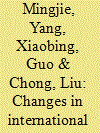

|
|
|
| 6 |
ID:
133795
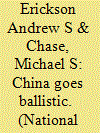

|
|
|
|
|
| Publication |
2014.
|
| Summary/Abstract |
China's growing missile and nuclear forces will pose a complex, challenging threat to America and its allies.
CHINA IS INCREASINGLY A FORCE TO BE RECKONED WITH, not only economically but also militarily. Its aggressive stance toward some of its neighbors, along with Asia's growing economic importance and the need to assure U.S. allies that Washington will increase its attention to the region despite budgetary challenges and fractious domestic politics, prompted the Obama administration to announce a "rebalance" toward Asia.
|
|
|
|
|
|
|
|
|
|
|
|
|
|
|
|
| 7 |
ID:
133995
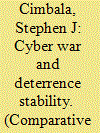

|
|
|
|
|
| Publication |
2014.
|
| Summary/Abstract |
Nuclear deterrence and cyber war are often discussed as separate worlds of research and military-strategic practice. To the contrary, a certain degree of overlap between nuclear deterrence and cyber conflicts is a plausible expectation for several reasons. First, future deterrent challenges will include regional nuclear arms races accompanied by competition in information technology and other aspects of advanced conventional command-control and precision strike systems. Second, cyber-attacks may be used against opposed nuclear command-control systems and weapons platforms as well as against infrastructure for the purpose of mass disruption during a crisis or war. Third, cyber capabilities support escalation dominance or escalation control, depending on the objectives of states and on the transparency of identification for cyber friends and foes.
|
|
|
|
|
|
|
|
|
|
|
|
|
|
|
|
| 8 |
ID:
129338
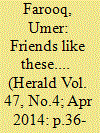

|
|
|
| 9 |
ID:
151233
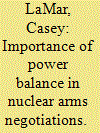

|
|
|
|
|
| Summary/Abstract |
Theorists debate whether symmetry or asymmetry of the power balance can help bring about bargaining success. Arbitration is difficult because the ‘Symmetry Theory’ accepts Structuralist theoretical conventions, while the ‘Asymmetry Theory’ rejects such conventions. This article employs a ‘Nuclear Weapons Addendum’ to strengthen the Asymmetry Theory by allowing it to explain bargaining results in symmetric and asymmetric cases without dismissing Structuralist assumptions. We analyze comparative case studies of the Cuban Missile Crisis and the Intermediate-Range Nuclear Forces Treaty to argue that this modified Asymmetry Theory provides a more convincing narrative that should be considered in Structuralist discussions of international negotiation.
|
|
|
|
|
|
|
|
|
|
|
|
|
|
|
|
| 10 |
ID:
054348
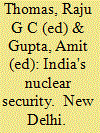

|
|
|
|
|
| Publication |
New Delhi, Vistaar, 2000.
|
| Description |
vi, 323p.
|
| Standard Number |
8170369800
|
|
|
|
|
|
|
|
|
|
|
|
Copies: C:1/I:0,R:0,Q:0
Circulation
| Accession# | Call# | Current Location | Status | Policy | Location |
| 043988 | 355.8251190954/THO 043988 | Main | On Shelf | General | |
|
|
|
|
| 11 |
ID:
190509
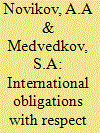

|
|
|
|
|
| Summary/Abstract |
Based on a review of international agreements between Russia (USSR) and the US on controlling strategic offensive weapons, the authors analyze progress in the system of nuclear arms control. This article assesses the current state of the system and offers ideas for possible avenues of improvement, taking into account Russia's approaches to safeguarding strategic stability and international security.
|
|
|
|
|
|
|
|
|
|
|
|
|
|
|
|
| 12 |
ID:
100540
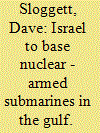

|
|
|
| 13 |
ID:
133634
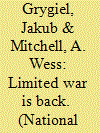

|
|
|
|
|
| Publication |
2014.
|
| Summary/Abstract |
EUROPE NEEDS to rearm and defend itself to cope with a new military threat. The American security umbrella-in both its conventional and nuclear forms-is no longer adequate, particularly on NATO's vulnerable eastern flanks. Indeed, the extended deterrent provided by the United States to its most exposed allies may not be well suited to inhibiting attacks similar to Russia's recent incursion into Ukraine, which displayed all the hallmarks of the newly popular limited conventional wars-brief and decisive, violent and yet very restrained. The purpose of such conflicts is to achieve a quick fait accompli in a geographically circumscribed area through limited force-in this case, paramilitary means followed by Russian regular forces. It is difficult to deter such a threat through the promise of retaliation, which by its very nature must occur after the facts on the ground have already been changed. A threat of retaliation is simply less credible when the enemy has achieved his objective through a low-intensity action. What are needed instead are strong local military capabilities-a preclusive defense-that increase the costs of that limited attack. Europe must start to defend its border rather than indulge in the belief that the traditional formula for deterrence, based on retaliation and the extended deterrent provided by the United States, will suffice. It won't.
|
|
|
|
|
|
|
|
|
|
|
|
|
|
|
|
| 14 |
ID:
143700
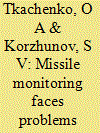

|
|
|
|
|
| Summary/Abstract |
The authors address the varied problems besetting missile development under the current Treaty between the Russian Federation and the United States of America on Measures for the Further Reduction and Limitation of Strategic Offensive Arms (New START, or SOA III). They survey naturally existing problems and offer ways of resolving them.
|
|
|
|
|
|
|
|
|
|
|
|
|
|
|
|
| 15 |
ID:
100648
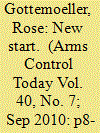

|
|
|
| 16 |
ID:
128065
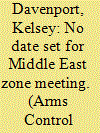

|
|
|
|
|
| Publication |
2013.
|
| Summary/Abstract |
Middle Eastern countries gathered last month to discuss the agenda for a conference on creating a zone free of weapons of mass destruction (WMD) in the Middle East, but made no announcement that they had made progress toward setting a date to convene the conference. The countries continue to disagree over the agenda, an official familiar with the process told Arms Control Today in an Oct. 29 e-mail. Iran, Israel, and all the Arab League countries attended the meeting, which was held Oct. 21-22 in Glion, Switzerland. Progress on the agenda has been held up over disagreements as to what weapons the zone's ban should cover because some countries favor expanding the ban to include limits on certain types of conventional weapons, the official said. The countries might meet again this month, the official added, but it is unclear if all will attend given the "frustration" over the lack of progress.
|
|
|
|
|
|
|
|
|
|
|
|
|
|
|
|
| 17 |
ID:
100650
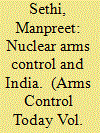

|
|
|
| 18 |
ID:
101079
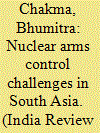

|
|
|
|
|
| Publication |
2010.
|
| Summary/Abstract |
The idea of arms control has hardly taken root in South Asia. The existing nuclear arms control measures between India and Pakistan are patently inadequate for addressing the pressing nuclear concerns of the region. Although there are compelling reasons for nuclear arms control, India and Pakistan are reluctant to undertake worthwhile arms control initiatives. There are three key reasons for this: India and Pakistan are currently at the formative phase of their nuclear force-building and at this stage they are unlikely to undertake arms control measures fearing that it may affect their future force-building plans; their intense political rivalry is unfavorable for successful arms control; the extra-regional links-the China factor-of South Asia's security dilemma hinders prospects for arms control in the region. Owing to these factors, the prospects for successful arms control between India and Pakistan are not great in the foreseeable future, although the question remains as to how long they can ignore the issue.
|
|
|
|
|
|
|
|
|
|
|
|
|
|
|
|
| 19 |
ID:
077737
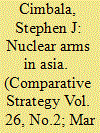

|
|
|
|
|
| Publication |
2007.
|
| Summary/Abstract |
Neither a balance of power model nor a balance of terror model can predict with assurance whether nuclear Asia will be stable or unstable. Even if fewer than eight states in Asia become nuclear weapons states, the problems of crisis management and escalation control, growing out of clashes between conventional armed forces, becomes harder to manage. As well, nuclear weapons have psychological effects on their owners, and not always predictable ones. Classic balance of power theory, written prior to the nuclear age, anticipated the use of small wars for intrasystemic adjustments without the elimination of major actors. Balance of terror theory regards small nuclear wars as possible escalators into larger ones. Europe's nuclear experience may be a misleading guide for twenty-first century Asia - with regard to the effects of both power and terror relationships
|
|
|
|
|
|
|
|
|
|
|
|
|
|
|
|
| 20 |
ID:
103804
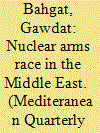

|
|
|
|
|
| Publication |
2011.
|
| Summary/Abstract |
Since the early 2000s Iran's nuclear program has been a major focus of international and regional policy. Many policy makers and scholars have expressed their concern that if Iran "goes nuclear" other Middle Eastern countries, particularly Egypt, Saudi Arabia, and Turkey, will follow suit. This author argues against this conventional wisdom. As a NATO member, Turkey is a special case. The analysis suggests that security is the main reason why countries pursue nuclear weapons. Egypt and Saudi Arabia (along with other Arab countries) have learned how to live with a perceived nuclear Israel. Iran with a nuclear capability, if it happens, would not pose a security threat to either Cairo or Riyadh. In short, the author argues that an Iran with nuclear capability will further destabilize the Middle East and will be a negative development, but it is not likely to make Egypt and Saudi Arabia "go nuclear."
|
|
|
|
|
|
|
|
|
|
|
|
|
|
|
|
|
|
|
|
|